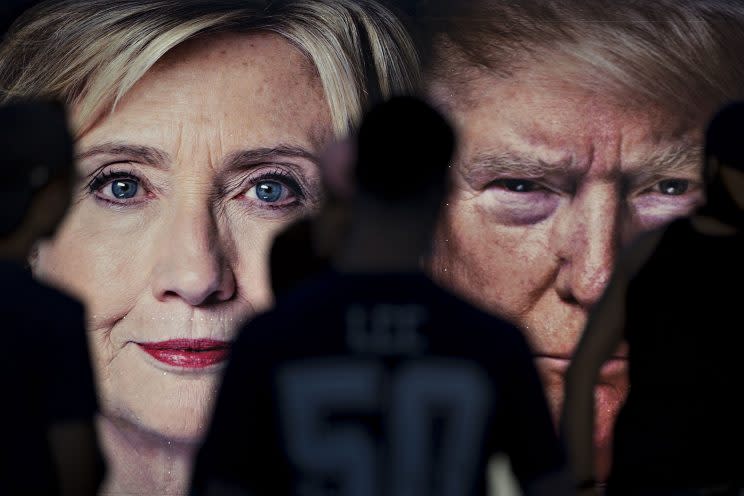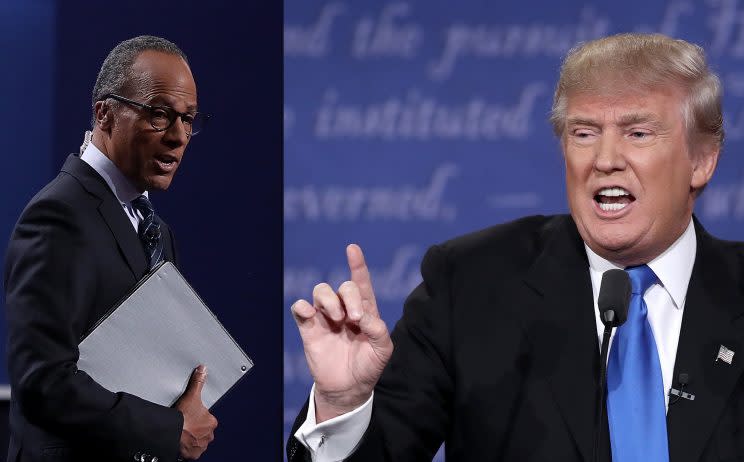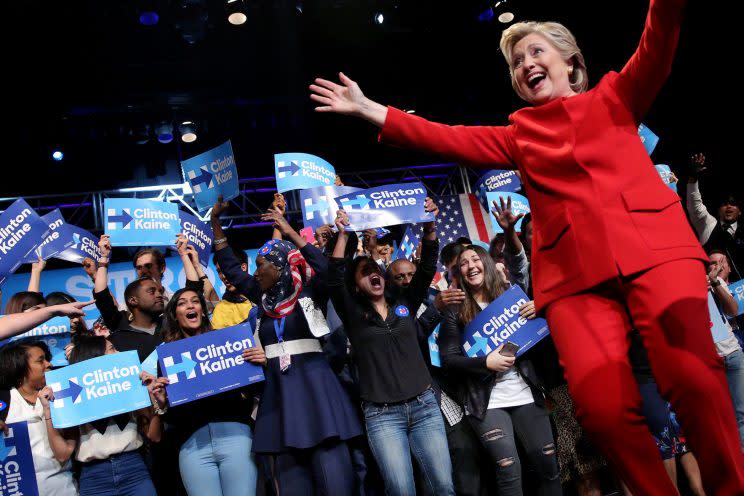Dissecting That ‘Presidential Look’: All the Ways Appearance Could Sway Votes to Trump or Clinton

During a key moment in Monday night’s presidential debate, moderator and “NBC Nightly News” anchor Lester Holt asked Donald Trump to clarify comments he made earlier this month in which he said that Hillary Clinton did not have “a presidential look.”
“She doesn’t have the look,” Trump shot back. “She doesn’t have the stamina. … To be president of this country you need tremendous stamina.”
Come November, it remains to be seen whether or not American voters think “stamina” is something that’s determined by how someone looks. But when it comes to a candidate’s appearance, it seems that everyone has strong opinions.
Fox News’ Brit Hume assessed Clinton’s debate performance as “composed, smug sometimes, not necessarily attractive.” The Atlantic’s David Frum criticized Clinton for “smiling like she’s at her granddaughter’s birthday party” during the debate. And earlier this month, Republican National Committee Chairman Reince Priebus took issue with the fact that Clinton did not smile during her participation in a national security forum.

On the other hand, pundits’ assessment of Trump’s debate performance ranged from “flustered” to successfully landing “humorous” lines pointed at Clinton. And those #TrumpSniffles that debate watchers swear they heard? After calling so much attention to Clinton’s bout of pneumonia earlier this month, Trump was quick to tell news outlets Tuesday that he wasn’t sick at all but rather had a faulty mic — since looking sick at a debate certainly isn’t promising for a person trying to construct an appearance of unmatched stamina.
‘Looking competent’ is a particularly strong predictor of electoral success
Research shows that “facial stereotyping” — using how someone looks to form judgments about his or her underlying character traits, from competency and trustworthiness to even political stances — is a real phenomenon, one that can influence decision making, including that of voters when they step into the voting booth on Election Day.
Christopher Olivola, who holds a joint PhD in psychology and social policy and is an assistant professor of marketing at Carnegie Mellon’s Tepper School of Management, is one of the leading researchers in this area.
“Candidates seem to benefit in terms of vote shares earned from having faces that make them appear to voters to possess desirable traits,” says Olivola. “Specifically, what we have done in our studies is present naive human judges — people who don’t recognize the candidates — with headshots (photos only showing the face) of the Democrat and the Republican running against each other in an election.”
When Olivola and his research colleagues asked participants to evaluate the faces on a particular dimension or characteristic, like which candidate looks more competent to them based solely on the face, they found that the candidate whose headshot garnered the highest score when it comes to “facial competence” predicted the actual election vote shares, even after controlling for candidate gender, age, ethnicity, and incumbency status. And Olivola notes that research he and Alex Todorov of Princeton University have done has shown that “looking competent” is a particularly strong predictor of electoral success.
‘Facial stereotyping’ influences votes, but not always in the way you’d think
Olivola has also found that conservative voters in the U.S. are more likely to vote for a candidate — even a Democrat — who has what they perceive to be a stereotypically “Republican-looking” face. He notes that, interestingly, liberal voters do not seem to vote based on political facial stereotypes or to favor a candidate with a “Democrat-looking” face. These ideas of Democrat-looking and Republican-looking faces aren’t described by people as being indicative of any specific facial features, but rather just gut instinct based on someone’s overall intangible “look.”
Democrats running in the U.S. are less likely to receive votes the more they look stereotypically like “politicians” — as opposed to other kinds of leaders, such as those from the military or business world, notes Olivola. This revelation makes Donald Trump’s positioning as a businessman and political outsider seem savvy in swing states, as a keen way to subtly influence how voters perceive the way he does — or, perhaps more important, does not — seem like “a politician.” During Monday night’s debate, Trump consistently touted himself as someone who understands money and business and as someone who holds investments and real estate, but not as someone with years clocked in meeting rooms on the Hill.
Another factor: People prefer to vote for politicians who have dominant-looking faces in times of war, but switch to preferring candidates with more warm and approachable-looking faces in times of peace. Just this summer, President Obama announced the continued presence of 8,400 troops in Afghanistan, a reminder that the nebulous “war on terror” continues. And Trump has made a point of referring to himself as the “law and order” candidate — and tends to attract support around those who see defense strategy and criminal justice as political priorities — despite Clinton’s close ties to the military and her hawkishness both being well documented (and aspects for which she often faces criticism).
But Olivola is emphatic in clarifying one major takeaway from his research: “We are not saying — nor have we found — that appearances alone predict elections. That’s certainly not the case! Rather, we have shown that appearances also contribute to the factors that predict a candidate’s eventual vote share and therefore likelihood of winning an election.”

But what about gender stereotypes?
Kathleen Dolan, chair of the department of political science at the University of Wisconsin-Milwaukee, is an expert on how gender stereotypes influence how voters evaluate a candidate. She tells Yahoo Beauty that while people continue to hold certain gender stereotypes, surveys she has conducted with voters over the past six years show “people are less likely to see someone running for office in the same way they see a neighbor or a teacher.” That is, while gender stereotypes might still be alive and well in civilian life, more often than not, those stereotypes don’t apply to how voters perceive their candidates. “Stereotypes are waning [in general] — but even when people do hold stereotypes, they’re not influencing a person’s evaluation of a candidate or how they vote at all.”
Dolan also explains that it’s important to remember that people who make a negative comment about a candidate’s appearance are people who are “never going to vote for that candidate in the first place.” And so when candidates have their appearances attacked, these attacks “don’t hurt and don’t drive down support, because the people who hold those [negative attitudes and opinions] don’t think favorably of that candidate to begin with.”
That said, Dolan notes that “candidates themselves and campaign operatives spend an enormous amount of time trying to anticipate gender reactions and neutralize gender reactions.” She points to the infamous Hillary Clinton pantsuit as an example.
“When [Clinton] was in the Senate, there was a time when she was wearing a tank top under a suit, and someone said something about her cleavage,” Dolan says. “And at some point, she clearly made a conscious decision that she would wear a pantsuit and only a pantsuit, and the only thing that would change is the color. She has clearly tried to neutralize people looking at her and trying to have some reaction based on what she looks like. She has trained people not to see what she wears — and this is after years and years of people having something to say about her hair.”
But neutralizing the appearance of gender isn’t a given when it comes to female candidates trying to make sure they appear appealing to voters.
“You can find women candidates like Hillary Clinton who have really scrubbed their appearance of much of what looks like ‘woman’ and then contrast that with [United States Senator from New York] Kirsten Gillibrand, who is very feminine and very stylish and fashionably dressed. [Congresswoman and House Minority Leader] Nancy Pelosi is another one — her closet is probably one of the best in the country. Some candidates have very feminine appearances and wear feminine clothes. But they have never run for president. So it’s hard to know if Hillary Clinton’s feeling of needing to ‘neutralize’ is a result of the office she seeks.” And yet Dolan says of Clinton’s “neutralized” wardrobe, “She probably gets bored of the pantsuit too, but in being the first, she felt she needed to dress and appear a certain way.”
How much do race and gender matter?
The way voters analyze the physical appearance of a candidate isn’t just about looking for attractiveness. Factors such as perception of race can also affect voters’ ability to “see” themselves in a candidate, and potentially think more favorably of him or her as a result (in what’s known in political-science-speak as “descriptive representation”). According to Deborah Schildkraut, chair of the department of political science at Tufts University, “Having a representative of the same race or gender on the ballot can certainly make it more likely that people will prefer that candidate. It does not, however, necessarily increase voter turnout. So, put simply, it can affect how people feel about politicians and political institutions and affect how people vote. But it won’t necessarily get people to the polls in the first place.”
Dolan notes that an interesting emerging trend — and one she doesn’t necessarily think is positive — is that voters automatically assume a woman candidate is superior to a male candidate, solely on their perception of her gender.
“Better, tougher, stronger, more honest — name your popular stereotype,” Dolan says of the tendency of voters to assume that female candidates are simply better. “People are starting to see women candidates as better than men — there’s a definite superiority thing that seems to be looming.”
Judging a candidate’s appearance may simply be a form of laziness
This kind of thinking might indicate what is known as a “low-effort route,” which focuses on things that are easier to process, like a person’s gender or appearance, for persuading decision making than the “high-effort route,” which requires people to think deeply about the arguments and issues at hand, says Art Markman, a professor of psychology at the University of Texas-Austin whose research focuses heavily on decision making.
“For a political candidate, it is always worth trying to align this low-effort route with the expectations of the people you are trying to persuade. The difficulty is figuring out what will fit the expectations of a group,” says Markman. “For example, Bernie Sanders is not attractive or powerful by conventional definitions — but his supporters resonated to his grandfatherly appearance and his rumpled look.”
Markman adds that while there is evidence that more attractive people are more persuasive than less attractive people, the Trump-Clinton face-off changes the game slightly, forcing two famous people, neither of whom has movie star looks, to seek out alternate low-effort routes to persuasion.

“Trump has done that quite well for the people he wants to persuade,” says Markman. “His appearance as a brash, wealthy businessperson is reassuring to people who are looking for a leader who embodies success.” Conversely, Markman says, “one problem that Clinton has had is that she looks uncomfortable on the campaign trail. That gives people the impression that she is hiding something, which has undermined her message at times.”
So while appearances may not be the only thing that makes or breaks an election — and this upcoming presidential election in particular — they still carry heavy implications.
“The implication [of how appearance affects the electorate] is that elections are being decided by superficial factors, and that is not a good thing,” Olivola says. “Moreover, as social media grows and people increasingly have access to photos of candidates, we can also expect the impact of appearances to grow over time, which is unfortunate, in my opinion.”
And yet, he adds, when it comes to the upcoming presidential election, with two incredibly public and well-known figures such as former Secretary of State Hillary Clinton and former reality television personality Donald Trump, “studies have shown that physical appearances have less of an impact among voters who are knowledgeable about the candidates, so they might not matter as much in this election. On the other hand, recognizing the candidates is different from knowing about them, so looks might still matter.”
Let’s keep in touch! Follow Yahoo Beauty on Facebook, Twitter, Instagram, and Pinterest.